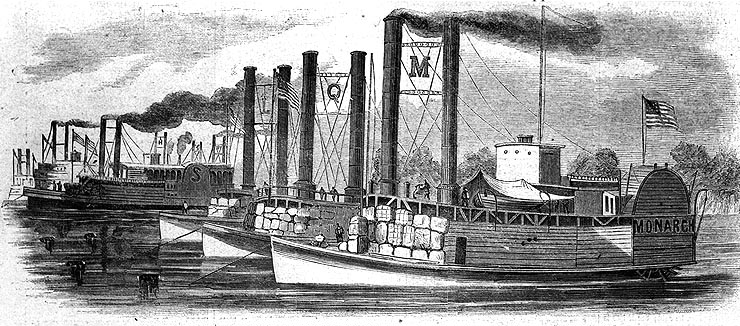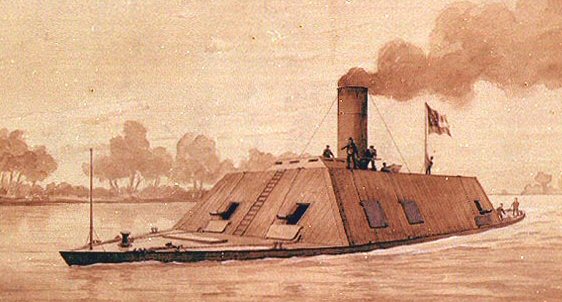Research Arsenal Spotlight 2: Alfred Washington Ellet, the US Ram Fleet and the Mississippi Marine Brigade
The US Ram Fleet

The US Ram Fleet and the Mississippi Marine Brigade served an important role in the Union army countering Confederate forces operating on and near the Mississippi River. The US Ram fleet was initially formed in March of 1862 under the command of Colonel Charles Ellet, Jr. Somewhat unusually, the US Ram Fleet was under control of neither the army nor the navy, and instead reported directly to the Secretary of War, Edwin M. Stanton.
As the name suggests, the US Ram Fleet was made up of a collection of steamships fitted with rams designed for crashing into other ships and thereby sinking them. The US Ram Fleet was created in response to the successful actions of the CSS Virginia in sinking both the USS Cumberland and the USS Congress on March 8, 1862 at the Battle of Hampton Roads.
In November of 1862, the Mississippi Marine Brigade was formed as a supplement to the US Ram Fleet, incorporating infantry, cavalry, and artillery units which would be transported by the fleet. Despite its name, the brigade was not part of the US Marines at any point. Both the US Ram Fleet and Mississippi Marine Brigade continued to serve directly under the Secretary of War until their disestablishment in August 1864.
The Ellet Family
Besides Colonel Charles Ellet, a number of other Ellet family members made up the command structure of the US Ram Fleet including Charles Ellet’s son, Charles Rivers Ellet, his nephew, John A. Ellet, and his brother, Alfred Washington Ellet. Also present was Alfred Washington Ellet’s young son, Edward.
Colonel Charles Ellet died from blood poisoning from a wound received at the First Battle of Memphis in June, 1862, and command of the US Ram Fleet then fell to Alfred Washington Ellet. Eventually raised to the rank of Brigadier General, Alfred Washington Ellet wrote a series of twelve letters to his wife and family back home in August, 1862, which are all available to read in the Research Arsenal’s Alfred Washington Ellet Collection, made possible through a partnership with Spared & Shared.
In these letters, Alfred Washington Ellet gives a frank view of the politics surrounding the US Ram Fleet, as well as numerous updates about his son Edward, who served with the fleet for a time as well as about his nephew, Charles Rivers Ellet, who would later go on to command the Mississippi Marine Brigade.
Edward “Eddy” Ellet
Edward Carpenter Ellet was born in 1845, the son of Alfred Washington Ellet and Sarah Jane (Roberts) Ellet, and was not yet 17 when he accompanied his father on the US Ram Fleet. Alfred Washington Ellet spoke very highly of “Eddy” and his bravery in letters home to his wife, telling her:
“I wish that you could have seen him [Edward] as he stood on that deck firing his pistol into the port of the rebel monster. Few men ever did a deed so daring yet so coolly. After firing five times, one barrel stopped. He stepped to my side, took a fresh cap from out of my pocket, capped the pistol and deliberately fired his last charge into the open port as we were passing. Show me an act of cooler self-possession if you can.”

The “monster” referred to in the passage above is the Confederate iron-clad ship CSS Arkansas. On July 22, 1862, the US Ram Fleet encountered the CSS Arkansas outside of Vicksburg. The Queen of the West of the US Ram Fleet rammed the CSS Arkansas but failed to sink her. It was likely during this fight that Eddy fired at her.
Plans for Taking Vicksburg
In a letter to his wife dated August 4, 1862, Alfred Washington Ellet detailed his own plan for taking Vicksburg and expressed frustration at it not being implemented.
“I think that nothing is so important as to open this river and nothing much easier to be done if we can only procure some concert of action. Vicksburg can be taken in two hours if they would only do as I proposed near a month ago to [Admirals] Farragut & Davis. Let these gunboats be pushed right up to the batteries at close quarters and silence them with grape and canister. Their guns are all exposed. And I will engage to land five hundred men and passing under our own fire, spike every gun before the enemy could know what I intended. Our boats would of course elevate their guns as I approached the forts so that their fire would still pass over me and fall so as to prevent the enemy from advancing from behind. This thing could be accomplished so quick, commencing at the upper fort and taking them in succession that it seems strange that it has not been accomplished. I have talked with Davis repeatedly about it but he fears to bring his boats to close quarters. [As] for myself, I want to see more close quarters fighting. We have stood off from these villains long enough and now I want to see them “crowded to the wall.”
Ellet also added,
“I tell you that all that high falutin idea of southern chivalry is played out entirely with me. I have had too many balls whistle by my ears aimed by some lurking villain who took good care to keep out of sight for me to entertain any longer any refined notion about the way of carrying on this war. I am now for crushing out this rebellion if with it the life of every traitor, man, woman and child in the South should be made a sacrifice of, and the whole country made a desert waste. Let us fight the thing out with clean hands and without gloves.”
As it was a shot by a sharpshooter that led to the death of his brother, Colonel Charles Ellet (who was also the only Union casualty if the First Battle of Memphis), it is easy to believe that that incident hardened his views.
In the end, Vicksburg was not taken by the Union army until July 1863, after a long siege. Alfred Washington Ellet’s plan of attack proved to be too risky to attempt.
Relations with the Army and Navy
After the unsuccessful fight against the CSS Arkansas, Alfred Washington Ellet had considerable anxiety about how the incident would be portrayed in the press as well as his position of leadership as head of the US Ram Fleet. In a letter dated August 10, 1862, he was finally much relieved in that area:
“[Charley] brought me the gratifying intelligence of the favorable light that my recent fight was looked upon by the people East, and the manner that the whole affair was set before the public by the press. I have felt extremely anxious upon this subject knowing how easy it was to crush me by an unfair statement even of facts, but of this I have no longer any apprehension. Secretary Stanton evidently intends that I shall have full justice and I rely upon him. I mentioned in my last that he says that he ‘will present my name to the President to be nominated for Brigadier General.’ This is sufficient evidence that he does not blame me for the late failure.”
He went on to tell his wife that she should not speak ill of other commanders, saying,
“I do not want you to express the feelings to others that your letters exhibits towards the commander in writing to me. I have fought my way into a position that I have nothing to fear from them, and the country has everything to gain from the knowledge that a cordial state of feelings exist between the commanders of the two fleets.”
Actions on the Yazoo River
In late August, 1862, Alfred Washington Ellet and the US Ram Fleet traveled up the Yazoo River successfully seizing and destroying large quantities of Confederate goods and ammunition. Describing the seizure Ellet said:
“We landed under the fire and found that we had got a prize again. The guns were not yet in position. Four heavy siege guns were lying by the side of their carriages, two brass field pieces, their mountings all laying close by, tons and tons of ammunition, shot, and shell in the greatest abundance, barrels and barrels of powders and quantities of “fixed” ammunition in boxes for the field piece, and 20-lb howitzers. We all went to work immediately to save what was of value to us and destroy the balance. We rolled all the solid shot into the river and the powder likewise. All the valuable prepared ammunition we took on board. The small cannon we also got on board, but we could not handle the large ones and were consequently obligated to burst them. So you see we have frustrated the little plan of this enemy for our future benefit. They must look out for more guns and another supply of ammunition before they can dispute our passage of the Yazoo at Hayne’s Bluff.”
The fleet was able to return safely with the prize and continued to act through out the war until its eventual disestablishment in 1864.
Conclusion
The twelve letters of the Alfred Washington Ellet Collection give valuable insight into the mind of the man behind the US Ram Fleet at a time when he had only shortly taken command of it. With the US Ram Fleet operating outside of the direct command of the army or navy, special care had to be taken to ensure cooperation and planning, as well as smooth personal relations between the various commanders. The letters also reveal the strong presence of the Ellet family in the US Ram Fleet and the close family ties between them. You can read the twelve letters in full on the Research Arsenal.
We’d like to give a special thank you to William Griffing of Spared & Shared for his work in transcribing and sharing these letters.
Looking for more spotlights on our collection?
Try reading about the Chester Chapman Letters.

